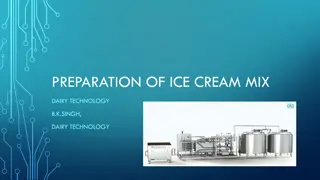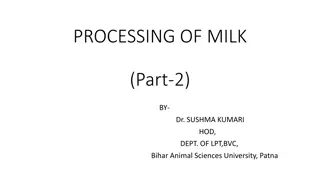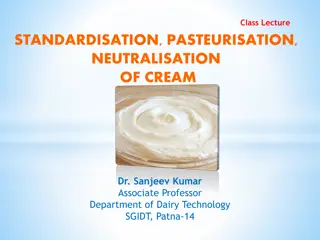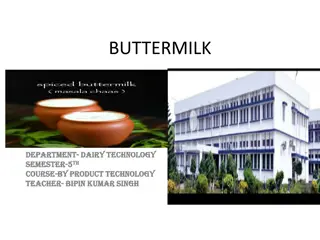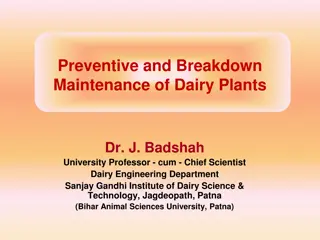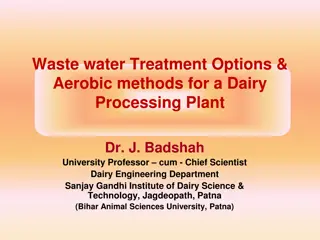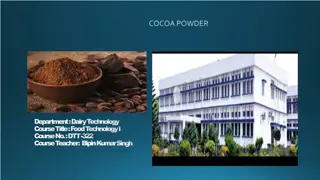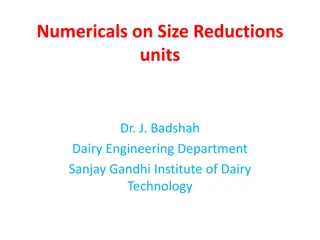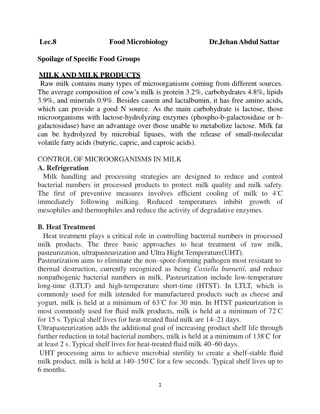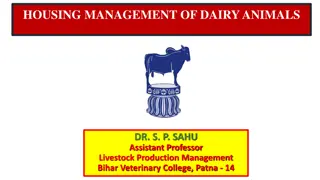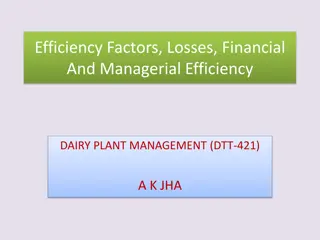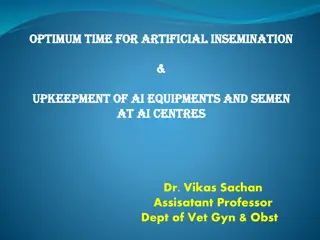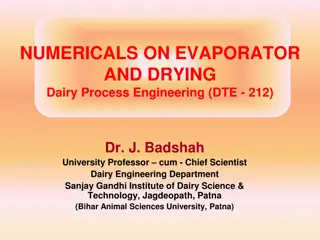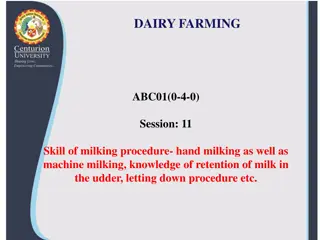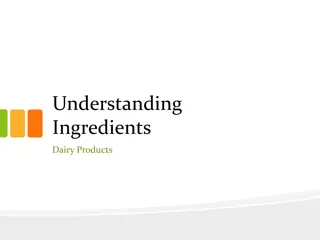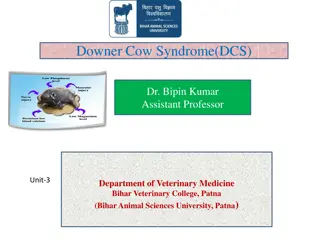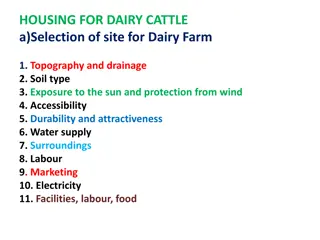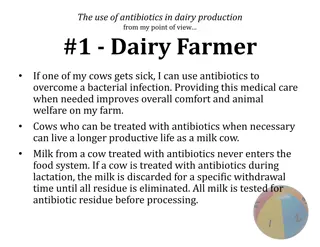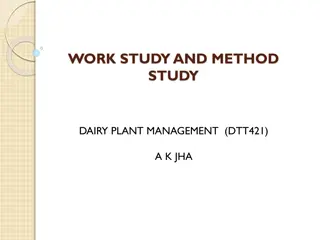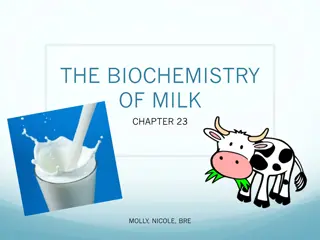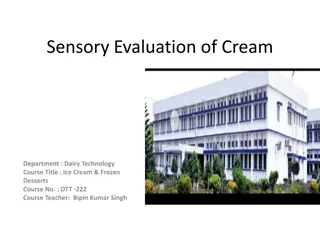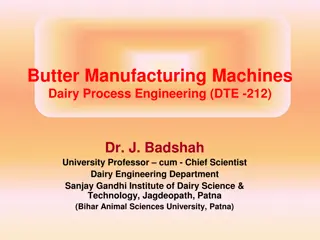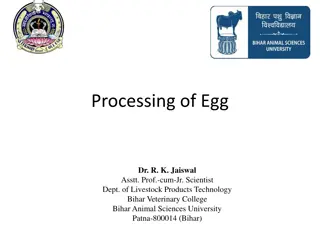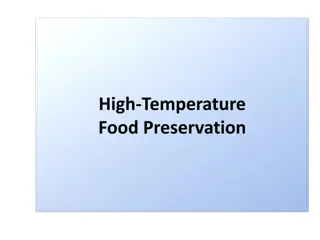Principles and Methods of Pasteurization in Dairy Technology
Pasteurization is a critical process in the dairy industry, named after Louis Pasteur. It involves heating milk to specific temperatures and durations to eliminate harmful microorganisms while preserving the product's quality. Important for ensuring milk safety, pasteurtization has limitations and various methods like Low-Temperature Long-Time (LTLT) and High-Temperature Short-Time (HTST). The process helps in improving milk shelf life and reducing spoilage organisms, although it does have drawbacks. Overall, understanding the principles and methods of pasteurtization is essential in dairy technology.
Download Presentation

Please find below an Image/Link to download the presentation.
The content on the website is provided AS IS for your information and personal use only. It may not be sold, licensed, or shared on other websites without obtaining consent from the author. Download presentation by click this link. If you encounter any issues during the download, it is possible that the publisher has removed the file from their server.
E N D
Presentation Transcript
Class Lecture PRINCIPLE AND METHODS OF PASTEURIZATION Dr. Sanjeev Kumar Associate Professor & Head Department of Dairy Technology SGIDT, Patna-14
Conti--- Conti--- Word pasteurization is derived from the name of an eminent French scientist Louis Pasteur (1860) Pasteurization came into use on a commercial scale in the dairy industry shortly after 1880 in Germany and Denmark Definition According to International Dairy Federation (IDF), : A process applied to a product with the object of minimizing possible health hazards arising from pathogenic microorganisms associated with milk by heat treatment, which is consistent with minimal chemical, physical and sensory changes in the product . In general, the term pasteurization as applied to market milk refers to the process of heating every particle of milk to at least 63 C for 30 min or 72 C for 15s or to any temperature-time combination which is equally efficient, in a properly operated equipment. After pasteurization, the milk is immediately cooled to 5 C or below.
Conti--- Importance of Pasteurization To render milk safe for human consumption by destroying all the pathogenic microorganisms. To improve the keeping quality of milk by killing almost all spoilage organisms (88-99%) Time-Temperature Combination for Specific Requirements All pathogenic organisms ---- destroyed by pasteurization, except spore forming organisms. The thermal death point of tuberculosis germs (Mycobacterium tuberculosis) --- slightly higher than that for inactivation of phosphatase enzyme. Pasteurization --- carried out at a heat treatment temperature above that for phosphatase inactivation and yet below that for cream line reduction. The pasteurization ensures complete destruction of pathogens, a negative alkaline phosphatase test and least damage to the cream line
Limitations of Pasteurization Encourage slackening of efforts for hygienic milk production and may mask low quality milk. Diminishes the cream line or cream volume. Pasteurized milk---- increase the renneting time. Fails to destroy bacterial toxins In India, pasteurization -- not necessary as milk is invariably boiled by the consumers
Methods of Pasteurization Low-temperature long-time (LTLT)/Batch pasteurization Milk --- heated to a minimum of 62.7 C and held at this temperature for minimum 30 min. It is then cooled as rapidly as possible to 4 C LTLT pasteurizer of three types Water jacketed vat Water spray type Coil-vat type
High-Temperature Short-Time (HTST) Pasteurization First developed ---- A.P.V. Co. in the United Kingdom in 1922 Modern method of pasteurizing milk -- invariably used where large volumes of milk . HTST pasteurizer gives a continuous flow of milk - heated to 72 C/15s followed by promptly cooled to 5 C or below.
Advantages Advantages Capacity to heat treat milk quickly and adequately, while maintaining rigid quality control . Less floor space required Lower initial cost Milk packaging can start as soon as milk is pasteurized Easily cleaned and sanitized (system adapts itself to CIP) Lower operating cost (due to regeneration system) Reduced milk losses Development of thermophiles is not a problem Automatic precision controls ensure proper pasteurization
Disadvantages Disadvantages system -- not well-adapted to handling small quantities of liquid milk products Gaskets require constant attention for possible damage and lack of sanitation Complete drainage --- not possible (without losses exceeding those from the holder system) Margin of safety in product sanitary control --- so narrow that automatic control precision instruments required in its operation Lethal effect on high-thermoduric bacteria in raw milk is not as great as compared to LTLT system Accumulation of milk-stone in the heating section.
Conti--- Conti--- Steps or stages -- involved as milk passes through the HTST pasteurizer: Balance tank Pump Regenerative heating Holding Flow diversion valve (FDV) Regenerative cooling Cooling by chilled water or brine An arrangement for incorporation of the filter/clarifier, homogenizer, etc., in the circuit --- also made possible
Conti--- Testing of Holding Time Holding time -- calculated between the points at which the heated milk leaves the heating section and reaches the FDV Efficiency of pasteurization in the HTST system depends on attaining the requisite temperature along with the desired holding time Methods - used for determining the holding time Electrical conductivity method (of a salt solution); Dye injection method; Electronic timer method
THANKS 11




